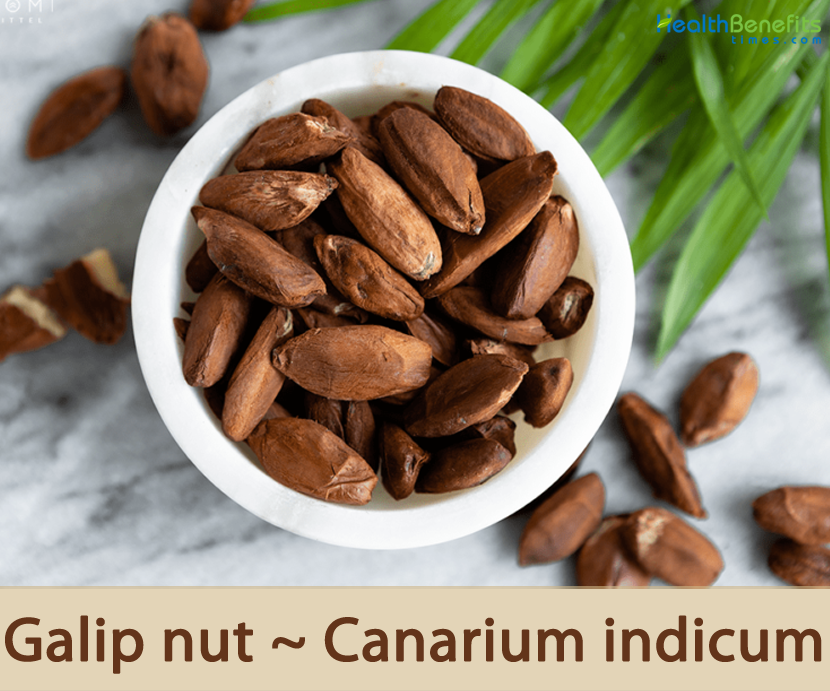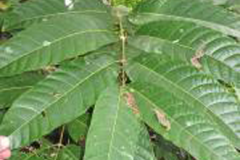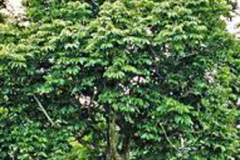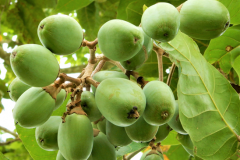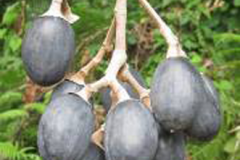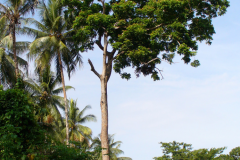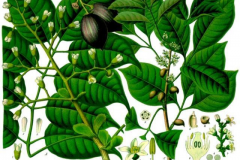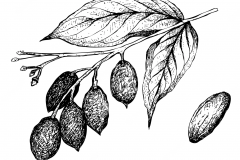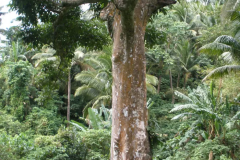The genus Canarium is derived from the Malay name kanari, the local name for one of the species. Galip nuts have high nutritional value and contain high oil, protein, vitamins and minerals content. The Canarium species have a similar composition to Macadamia nut. Galip nut is used as a shade tree, as a windbreak and in agroforestry. It is important in the world food system as it can be used as a food and timber source, in traditional medicine, intercropping and agroforestry. The seed is a highly valued food within the plants native range, where it is often collected from the wild and is also often planted around villages and settlements. The seeds are often sold in local markets, and have a significant commercial potential on a wider scale. The tree also yields a useful resin, has medicinal applications and a useful timber. Canarium nut is also grown as an ornamental and makes an excellent shade tree.
Galip Nut Facts
| Galip nut Quick Facts | |
|---|---|
| Name: | Galip nut |
| Scientific Name: | Canarium indicum |
| Origin | Eastern Indonesia, Papua New Guinea, the Solomon Islands, Vanuatu and surrounding islands |
| Colors | Initially green turning to deep dark green to black when ripe |
| Shapes | Ovoid to elliptic-oblong drupe, 3–6 cm (1.2–2.4 in) long and 2–4 cm (0.8–1.6 in) wide |
| Taste | Milky, nutty flavor |
| Health benefits | Good for Heart, Improves Skin Elasticity and Appearance, May Improve Blood Sugar Levels, Can Support Gut Health, Overcome Insomnia, Fight Disease, Bone Health, Promotes Skin and Hair Health, Weight Loss, Help Fight Inflammation |
| Name | Galip nut |
|---|---|
| Scientific Name | Canarium indicum |
| Native | Humid, lowland zones of eastern Indonesia (Maluku, Ambon, Sulawesi, Moluccas, Irian Jaya, West Papua), Papua New Guinea, the Solomon Islands, Vanuatu and surrounding islands. It is frequently cultivated in Melanesia. It is also cultivated in Australia, Taiwan, Fiji, Hawaii, Honduras and Trinidad |
| Common Names | Java almond, Blume galip, canarium almond, canarium nut, galip nut, Java olive, molucca nut, nangai nut, ngali nut, Ngali, kenari nut, Angari, Hinuei, Jangli badam, Java badami, Kagli mara, Kanari, Keanee, Kenari, Lawele, Ngari, Ngoeta, Nolepo, Nyia nyinge, Nyia Nyinge, Okete, Pili, Rata kekuna, Sela, VoiÕa |
| Name in Other Languages | Bichlamar: Nangai Bislama: Nangai Bulgarian: Indiĭski kanarium (индийски канариум) Chinese: Dōng yìndù gǎnlǎn (东印度橄榄), goma-limão ENGLISH : Blume galip, Galipnut, Java almond, Kanari, Nangai nut, Ngali nut, Java-olive, Canarium-nut, Galip, canary nuts, elemi, kenari nut Fiji: Galip, Galip nut Finnish: Molukkienelemi French: Nangai, Noix de nangaille, Nangaille, Nangailler, amandier de Java, arbre à baume, noix canari , Canari commun German: Indisches Kanaribaum, Kanarinuß, Galipnuss, Javamandel, Kanarinuss, Kanarinussbaum, Galipnuß, Kanarienbaum, Gemmeiner, HINDI : Agarbati, Dhup Indonesian: Kenari ambon, kanari ternate, kanari bagea, jal, Jar, Buah Kenari Italian: Elemi Malay: Upi,seladah,kerantai Malaysia: Canari, Nangai, Ngali, Kenari, Pokok Kenari Papua New Guinea: Red canarium, galip, lawele, hinuei, Lauele, Baga, Galip Nut, angallip Polish: Kanarecznik zwyczajny Portuguese: Amendoeira-de-java, elemi Russian: Kanarium indiyskiy (Канариум индийский) Solomon Islands: Eghe, Ninge, Nina, Voia, Angari, Ngari, Nyia Nyinge, Ngoeta, Okete, Nolepo, Sela, Ngali Nut, Voi‘A, Ngali, Kwakora, Aneri, Olaipa Swedish: Nangainöt Tamil: Rata kekuna Vanuatu: Nangai, Nangrau, Bunnige, Nige Kava, Punnige, Nige Karia, Ngapor, Negerdove, Ngaqov, Ngaetua, Vungaingai, Vungigae, Nanae, Vanae, Nangae, Nangan, Ngna, Nanga, Ngeta, Ngev Tentel |
| Plant Growth Habit | Evergreen, dioecious, medium-sized to fairly large tree |
| Growing Climates | Rainforests, secondary forests, old garden areas, around villages and settlements. It can also be found near the coast |
| Soil | Naturally grow well on a wide range of soil types, preferably with well drained, deep, friable, sandy loam soil with good organic matter content and a pH of 4.5 – 6.5. Trees will tolerate alkalinity up to pH 7.4. |
| Plant Size | Grows up to 25 meters tall and exceptionally up to 40 meters. The straight, cylindrical bole is short, branchless up to 10 meters, up to 100 cm in diameters, with tall but thin buttresses up to 1 m high at the base |
| Bark | Bark surface smooth to scaly and dippled, grey or brownish-grey to yellow-brown, inner bark laminated, reddish-brown to pinkish-brown, exuding a milky resin; stipules persistent, rarely inserted on the petiole, ovate to oblong, large and prominently dentate |
| Leaf | Leaves with 7-15 leaflets, leaflets with apex gradually to distinctly acuminate, margin entire, glabrous, with (8-)10-15(-20) pairs of secondary veins which are slightly sunken above and prominent below |
| Flowering season |
|
| Flower | Flowers are small 1 cm (0.4 in) across, and yellowish white. Perianth parts, sepals and petals, are arranged in threes, densely and finely hairy on the outside. |
| Fruit Shape & Size | Ovoid drupe, 3 – 6cm long and 2 – 3cm wide, circular to slightly triangular in cross-section, glabrous. Seed usually 1. |
| Fruit Color | Initially green turning to dark purple in color as they mature |
| Taste | Milky, nutty flavor |
| Plant Parts Used | Bark, nuts, seeds, resin |
| Propagation | From seed, either as nursery-raised seedlings or by direct-seeding into the field or by asexual methods, such as marcotting, grafting or budding. Vegetative propagation methods like budding and grafting are practiced for the fruit production |
| Health benefits |
|
| Precautions |
|
Plant Description
Galip nut is an evergreen, dioecious, medium-sized to fairly large tree that normally grows up to 25 meters tall and exceptionally up to 40 meters. The straight, cylindrical bole is short, branchless up to 10 meters, up to 100 cm in diameters, with tall but thin buttresses up to 1 m high at the base. The form typically is a reasonably well formed tree with short–medium length bole to about half the tree height, with heavy lateral branches and a dense canopy. The trunk is commonly buttressed, with steep or even buttresses up to 1.5 m (5 ft.) high. Bark surface is smooth to scaly and dippled, grey or brownish-grey to yellow-brown. Inner bark is laminated, reddish-brown to pinkish-brown, exuding a milky resin. Stipules are persistent, rarely inserted on the petiole, ovate to oblong, large and prominently dentate.
The plant is found growing in rainforests, secondary forests, old garden areas, around villages and settlements. It can also be found near the coast. The plant naturally grow well on a wide range of soil types, preferably in well drained, deep, friable, sandy loam soil with good organic matter content and a pH of 4.5 – 6.5. Trees will tolerate alkalinity up to pH 7.4. It prefers medium to heavy textured soils, like loams, clays, clay loams and sandy clays of moderate to high soil fertility. However, they can be found in poorly drained sites in forest situations and growing on the beach near the sea. They are intolerant of shallow, infertile, or saline soils. They naturally grow between 200 and 300 kg/m3 in density. Canarium nut is amongst the oldest and most important tree crops in Melanesia, and is an integral part of one of the world’s first known permanent agroforestry systems.
Leaves
The leaves are bright to dark green, imparpinnate with 6 – 10 pairs of leaflets on a rachis to 30 cm (12 in) long. Individual leaflets are oblong-obovate to oblong-lanceolate and typically 7–28 cm (2.7–11 in) long and 3.5–11 cm (1.4–4.3 in) wide. Stipules are persistent, ovate with toothed or notched margins, large and conspicuous typically 1.5–6 cm (0.6–2.4 inches) long and 1.3–4 cm (0.5–1.6 inches) wide, but up to 10 cm (4 inch) long and 5 cm (2 in) wide are located at the junction of the petiole and branch. Pseudo-stipules, however, are persistent, large, leafy, ovate and serrate-dentate with fringed margins.
Flowers
The flowers are arranged in terminal panicles, 15–40 cm (6– 16 in) long, with stipules at the base and bracts of flowers, the latter soon deciduous. Flowers are small 1 cm (0.4 in) across, and yellowish white. Perianth parts, sepals and petals, are arranged in threes, densely and finely hairy on the outside. In PNG and the Solomon Islands, the species is dioecious, with separate male and female flowers being borne on different trees. In Vanuatu trees may also bear either hermaphrodite flower (sexually-functionally male and female) plus female flowers; or hermaphrodite flowers plus male flowers. The proportion of hermaphrodite and unisexual flowers differs considerably from one tree to another, but unproductive non-fruiting male trees are very rare in Vanuatu.
Flowering appears to be initiated by changes in day length. Accordingly, the onset of flowering depends on latitude, such that at about 3–4°S it starts in about April, while at 11°S its starts around September. In Vanuatu cyclones in the previous year can lead to earlier flowering in the following year, e.g., starting in July–August. In the Solomon Islands canarium nut trees generally flower at the beginning of the year during the wet season. Under good conditions trees commence flowering about 5–7 years after planting.
Fruit
Fruits are borne on erect or slightly drooping stems, which are held, clear of the canopy. The fruit is an ovoid to elliptic-oblong drupe, 3–6 cm (1.2–2.4 in) long and 2–4 cm (0.8–1.6 in) wide and generally green when unripe, turning deep dark green to black when ripe. The nut found in the shell is stony, hard and can be rounded or 3-6 sided in cross section. Kernels are usually trigonous, 1 cm across, with brown testa. In PNG the fruiting season, which lasts about 3 months, is reported to be fairly constant from year to year (May–July). In the Solomon Islands fruits start to mature in August, with production peaking between September and October. Trees in the Western Province fruit a little earlier than those in more eastern provinces. In Vanuatu the normal fruiting season is between October and January with a peak in November. Fruiting commences at about 7 years after planting.
The fruits are dispersed by fruit-eating pigeons, wild pigs, rodents and monkeys, and are occasionally eaten and dispersed by bats. Humans gather the fallen fruits and seeds, and may thus be considered a constraint to the successful dispersal of the species, significantly reducing the natural stand of seedlings in communities and forests
Seeds
The nut-in-shell (NIS) is three- to six-sided or rounded with one (or sometimes two or three) kernels. Nut properties vary considerably, e.g., NIS range of 28–62 mm long and 20–35 mm wide, with a fresh weight of 8–20 g (0.3–0.7 oz.) in the Solomon Islands. The same figures for NIS of selected nut trees in Vanuatu were 36–56 mm long and 23–34 mm wide, with a fresh weight of 9–18 g (0.3–0.6 oz.). The fleshy mesocarp of the fruit is an important food for many animals, in particular flying foxes and pigeons, who act as seed dispersal agents.
Health benefits of Galip nut
Galip nuts consist of high amount of protein, calcium, and potassium. Galip nut benefits make it a healthy snack option. This super food has a ton of health benefits. Half of the fat found in one nut comes from heart-healthy monounsaturated fat. These healthy fats aid in lowering bad cholesterol levels and, in the long run, reduce your risk for heart disease. Listed below are some of the popular health benefits of consuming Galip nuts
1. Good for Heart
Galip nut can help keep the arteries in good condition. Because they’re rich in monounsaturated fat, they can also help reduce cholesterol levels and lower triglycerides, both of which are risk factors for coronary heart disease. (1)
2. Improves Skin Elasticity and Appearance
Research has shown that palmitoleic acid, the omega-7 fatty acids found in Galip nuts, may promote skin, nail, and hair health. They do so by protecting against oxidative damage, which is one of the main culprits of skin aging, by encouraging and suggesting new skin cell development.
Some research has shown this rare fatty acid may improve the body’s synthesis of elastin and collagen, which are proteins that keep your skin young, strong, and reduce the appearance and onset of wrinkles. (2)
3. May Improve Blood Sugar Levels
Nuts, in general, are known to relieve the impact of certain health issues that come along with diabetes. This statement is further proved by a Canadian study that states that tree nuts (including Galip nuts) can improve glycemic control in patients with type 2 diabetes. (3)
4. Can Support Gut Health
Galip nuts consist of good amount of fiber, which may promote gut health. Research shows that dietary fiber can have beneficial effects on gut microbiota. But the nuts are particularly rich in copper. Though it is supposed that copper supports the enzymatic reactions that improve digestive health, we need more research to confirm it. (4)
5. Overcome Insomnia
Galip nuts can also help you overcome insomnia and other sleep-deprived disorders. Well, Galip nuts are rich in many essential minerals, and one of them is magnesium. They actually consist of the highest magnesium content of any nut. This property makes galip nuts an excellent remedy for insomnia as magnesium treats the symptoms of insomnia and helps you sleep better at night. (5)
6. Fight Disease
Galip nuts contain flavonoids that help prevent cell damage by protecting cells from environmental toxins. These phenomenal flavonoids also act as antioxidants, which help fight free radical damage and protect against chronic disease.
7. Bone Health
Galip nut consist of a miscellaneous mix of minerals which are quite beneficial for our bones. Bone mineral density naturally begins to decay as we grow old, so it is important to increase our mineral intake, or at least ensure that it is in line with daily requirements. Galip nuts offer zinc, calcium, magnesium, copper, manganese, and phosphorous, many of which are important to keeping our bones strong, particularly as we age.
8. Promotes Skin and Hair Health
As we all know that Vitamin E helps improve your skin and hair quality. Vitamin E helps protect your body against many conditions like cholesterol sediments, and even activates antioxidants. Galip Nuts are one the richest source of vitamin E among all nuts, which is why they help promote your skin and hair health.
9. Weight Loss
High-fat snacks like Galip nuts can aid weight loss. It’s true that just an ounce of these nuts consists of 201 calories, most of which are from healthy fats. The dietary fiber in Galip nuts can help increase satiety by binding to water, making you feel full. Dietary fiber has been shown to increase feelings of satiety aiding in weight loss. These healthy fats may help reduce inflammation, one of the biggest contributors to weight gain.
10. Help Fight Inflammation
Inflammation is linked to diabetes, cancer, heart disease, weight gain, and a host of other diseases. But regular Galip consumption is linked to fighting inflammation. The reason why Galip nuts help combat inflammation is the magnesium. This mineral is essential for optimum bone and teeth health, blood clotting, and sleep regulation. Magnesium deficiency plays an important part in chronic inflammation, which may lead to a higher risk of chronic disease.
Traditional uses and benefits of Galip Nuts
- Preparation made from the bark is used for the treatment of chest pains
- Bark used for treatment of chest pains; oil used for arthritis pains; and oleoresin applied as poultice for ulcerated wounds.
- Dried old nuts ground into powder, mixed with cooked taro oil, and drunk to induce sterility.
- In the Solomon Islands, oil pressed from Canarium nuts is mixed with sorbolene and applied to the skin for all forms of arthritis.
- Kernel oil can be used in cosmetic and skin care products, in which anti-aging and anti-inflammatory agents of Canarium oil can stimulate tensin 1 expression and are thus effective against wrinkles and loss of skin firmness.
- In addition, Powell has reported that the masticated bark of C. indicum is used to treat burns.
Culinary Uses
- Seed can be consumed raw or cooked.
- The oily seed is consumed fresh, roasted or smoked.
- It can be eaten as a snack food or incorporated into various cooked dishes.
- Nuts which are removed from the shell and roasted can be stored in sealed containers for many months.
- The nuts are often coarsely ground and added to other foods.
- Edible oil can be obtained from the seed.
- In Melanesia the seeds are highly esteemed as a food.
- Oil from the seeds is used as a substitute for coconut oil.
- Kernels are eaten raw, baked or roasted, used as a snack or added to other food, such as staple root crops, soups or even crushed and used as ice-cream toppings.
- Depending on the regions, they can also be used in different ways; it can be mixed with tuber puddings in Vanuatu.
- Consume it as a snack food or add it to other foods with some staple root crops, soups or consume it with megapode eggs in the Solomon Islands.
- Crushed kernels are used as toppings in ice cream.
Other Facts
- Resin can be obtained from the trunk which can later be used as incense.
- Wood is used in light construction as it is soft and non-durable when exposed to weather.
- Canarium nut is wind resistant and ideal for establishing an agroforestry system.
- Plants are very wind resistant and make an excellent addition to the top storey of a shelterbelt.
- Canarium nut is amongst the oldest and most important tree crops in Melanesia, where it is an integral part of one of the world’s first known permanent agroforestry systems.
- Resin oozes from wounds on the trunk caused by a variety of natural factors such as pests/diseases, damage during cyclones, etc.
- Resin was formerly collected for use as canoe caulk and was burnt to give light.
- Resin is aromatic and has been used as incense.
- Soot from burning resin was formerly used as ceremonial black face paint.
- Oil extracted from the kernel has various local uses.
- It may be substituted for coconut oil and has potential in skin-care products.
- The oil-rich seeds can be strung together, then lit and used as torches.
- The pink-brown wood is soft and fine textured.
- It has a medium density and is non-durable when exposed to weather.
- It is suitable for light construction (in low-decay situations), moldings, veneer, and numerous interior purposes.
- Traditionally, the wood is used to make canoes, bowls and other wood articles.
- The wood is sometimes used as a fuel.
- Mature trees yield at least 100 kg/year of fruits when open grown and under plantation conditions they can be expected to yield 7700 kg/ha of fruits annually.
- Timber is soft and can be used for light construction, canoes, boats, tools and crafts.
- Flowering has been reported to commence after 5-7 years after planting and may take longer in areas with high rainfall.
- Burning resin is aromatic and was used in traditional ceremonies and churches.
Agroforestry/environmental Practices
- Crop shade: Mature trees cast a heavy, wide shade and are only suitable for providing crop shade to the most shade-tolerant crops, such as cocoa.
- Alley cropping: The species is not especially amenable to inclusion in alley cropping systems due to its shade requirement in the first few years.
- Home gardens: Canarium nut is a good candidate for inclusion in abori-culture systems and tree home gardens, e.g., at the rate of one to three trees per garden. The trees provide nuts for local consumption from an early age, coupled with reasonably good stability during strong winds and cyclones.
- Improved fallows: Not very well suited to inclusion in improved fallows, due to the long period between planting and fruiting and the high value of trees once they come into nut production (which would preclude their cutting to allow light for agricultural crops).
- Boundary markers: Good boundary marker due to high value (i.e., likely to be “valued” on both sides for nuts) and longevity.
- Windbreaks: An excellent species for inclusion in the upper story layer in windbreaks.
- Silvopasture: Likely to have some potential for growing in silvo pastoral systems, providing shade for livestock, and recycling nutrients from deeper soil layers, but trees would need to be grown at wide spacing to allow enough light for pasture to grow beyond the edge of the canopy.
- Woodlot: A good species for inclusion in mixed- or single-species woodlots for provision of timber and/or nuts.
- Native animal/bird food: Birds and bats consume the fleshy mesocarp of fruits.
Side Effects of Galip Nut
Galip nuts are largely safe, and the side effects are rare. But excess intake can cause allergies and high blood pressure.
Allergies
Ingestion of the nuts may cause a skin hypersensitivity reaction. Certain individuals have also reported experiencing allergies like coughing.
Blood Pressure
In case the nuts you purchased are salted, they can elevate your blood pressure levels. Hence, go for the unsalted (and unsweetened) variety.
Gastrointestinal Issues
They are good sources of fiber, having too many of these nuts can cause gastrointestinal issues. Too much of fiber has been associated with constipation. Certain individuals may also experience gas, diarrhea, and bloating.
Possible Issues in Pregnant and Breastfeeding Women
Galip nuts are safe when taken in normal amounts. There is no research available on the effects of excess intake of these nuts on pregnant and/or breastfeeding women. Hence, stick to normal amounts.
References:
http://www.theplantlist.org/tpl1.1/record/kew-2695906
https://www.itis.gov/servlet/SingleRpt/SingleRpt?search_topic=TSN&search_value=506412#null
https://npgsweb.ars-grin.gov/gringlobal/taxon/taxonomydetail?id=8815
https://pfaf.org/user/Plant.aspx?LatinName=Canarium+indicum
https://gd.eppo.int/taxon/CNBCO
https://uses.plantnet-project.org/en/Canarium_indicum_(PROSEA)
http://tropical.theferns.info/viewtropical.php?id=Canarium+indicum
http://www.stuartxchange.org/JavaAlmond
https://apps.worldagroforestry.org/treedb/AFTPDFS/Canarium_indicum.PDF
https://en.wikipedia.org/wiki/Canarium_indicum
https://www.cabi.org/isc/datasheet/11132
https://powo.science.kew.org/taxon/urn:lsid:ipni.org:names:127364-1
https://plants.usda.gov/home/plantProfile?symbol=CAIN42


